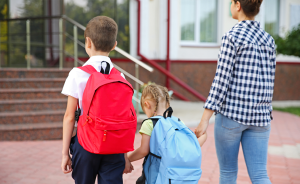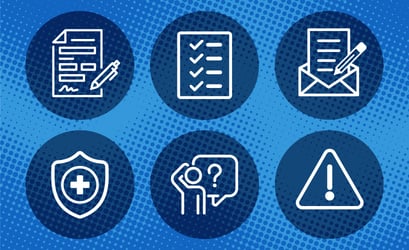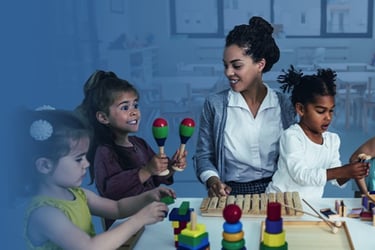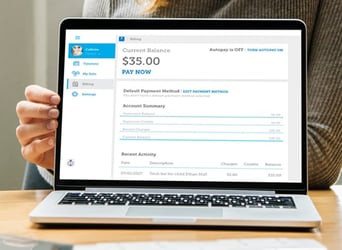Tips For Teachers On Easing Your Preschooler’s Separation Anxiety
You know the phrase “distance makes the heart grow fonder”? It obviously didn’t factor in preschoolers with separation anxiety. For young children, distance from their parents at the start of a new school year often leads to bouts of kicking, screaming, and crying for them to return.
Starting a new routine like preschool can be a difficult and stressful situation for kids. Their entire lives are changing and they’re thrown into a room of strangers. No wonder so many kids (and their parents) struggle with separation anxiety.
As a teacher, you have the challenging task of helping your students conquer their separation anxiety. Your actions can help every child feel safer on their first day—and every day after.
It may take a while for your students to get used to the new environment and rhythm. Be prepared for the first day of class to be difficult and tear-filled for everyone involved. But once your students have figured how to cope with their emotions, the rest of the school year will be a happier place for the parents, the children, and yourself.
Child Separation Anxiety 101
It’s natural for children to feel scared and anxious when away from their parents. Children with separation anxiety worry excessively when separated from their parents for any amount of time. Their anxieties can manifest themselves in a variety of ways:
- They refuse to leave their parent’s side or be away from them at all.
- They become easily agitated and have temper tantrums.
- They often complain about stomach aches, headaches, or other physical illnesses.
- They are anxious or emotional whenever they’re not by their parents.
- They worry excessively about losing their caregiver. This symptom could be more prominent this year from COVID-19 worries.
Children can experience separation anxiety for many reasons. Environmental factors like the illness or death of a parent, or a worldwide pandemic, can make children cling to something stable in their lives. A family history of anxiety or mental health issues can also contribute to an anxiety disorder. Some children’s personalities are also more sensitive to being away from their caregivers and can lead to separation anxiety.

There’s no straight answer on how long a student will have separation anxiety issues. It could be just for the first few days or weeks of class until they’re comfortable in their new routine. Their issues could be solved and then return after a family vacation. It could ebb and flow throughout the entire school year. Since there are many home factors that are out of your control as their teacher, it’s crucial for the relationship of both your students and their parents for you to be patient during this stressful time in their lives.
Separation Anxiety Tips for Teachers
Having an open house before school begins is a great way to meet and form relationships with your students and their parents. It also helps the children to meet you in a positive setting alongside their parents. This shows them you’re an adult they can trust. Ask their parents about any health issues you should know about, how their child expresses their feelings, or if they have a preferred emotional coping tactic. Let the students spend time in your classroom beforehand as well so they’re not coming in cold to a new setting on that first day.
Be sure at this time to acknowledge the parent’s feelings about leaving their kids. They could be anxious about the process. This may be the first time they’ve left their child for an extended amount of time, and preparing their child for preschool can be emotionally taxing. Help ease separation anxiety by answering all their questions and let them know how they can contact you should anything happen.
Creating a safe and fun classroom environment will go a long way in helping struggling students ease their separation anxiety. Allow children to bring a security blanket or toy with them if it makes them feel more comfortable. Hang photos of their family members around the classroom so they see a friendly and familiar face every day. Have them make an arts & crafts project to give to their parents at the end of the day. Making the classroom somewhere they want to come back to will help calm their anxieties.
Consider creating a visual daily schedule for students to follow—this helps children understand they didn’t get left behind by their parents and that they will see them again soon.
If a student is struggling to leave their parent at drop off, it’s helpful to have distractions on hand to ease separation anxiety. Toys can steer their attention away from their parents and help get them into the classroom. Let them know what activities they can look forward to—this will make it easier during drop off to get them excited for the day. Remember that your preschooler’s anxiety is a normal part of early childhood. How you, and their parents, handle separation anxiety will make a significant impact until the kids build trust that their parents will always come back at the end of the day.
Separation Anxiety Tips For Parents
As a parent, your behavior will impact how your little one feels about you leaving them for the day. This can be an emotional time for you, especially if this is the longest you’ve been away from your child before. But if you’re making a big fuss during drop off, your child will follow suit and become more anxious themselves. Keep a short and positive goodbye routine. Anything else will prolong your child’s anxiety and cement saying goodbye as a negative process.
Your child takes social cues from you. If they see that you’re nervous or scared for them to leave, it will be much more difficult for them to adjust and grow in this new environment. It’s important to keep a positive attitude and show them how exciting this new adventure will be.
It’s important to acknowledge your own emotions during this time—separation anxiety isn’t something that only children experience. You have a close and special bond with your child. It’s going to be difficult at first giving them space to grow and have new adventures without you.
If you’re feeling separation anxiety, there are things you can do to make this change easier. Now is the perfect time to connect with other parents who may be feeling the same way you are. A support group can help you overcome your anxieties and can be a welcome distraction. You may now have a lot more free time during the day—stay busy with fun activities you didn’t have time to do before. It will help the day pass quicker and help you feel fulfilled in other aspects of your life apart from parenthood.
How To Help Your Special Needs Student With Separation Anxiety
Special needs children will need a little extra TLC when starting preschool. Depending on the child and their level of functionality, they may struggle to understand why their parents are leaving and why their routine is being drastically changed.
It’s normal for special needs children to have difficulties communicating verbally. So when they get anxious from their caregiver leaving, they may react physically, yell, or cry to express their emotions. This can be stressful for everyone in the room. But patience, understanding, and lots of love are key to disarming the situation.
When meeting the parents of your special needs student, get as much background information as possible to avoid future issues:
- Stress coping mechanisms. Do they become violent when they act out? What do you do at home when they have an episode? What do you use to help distract them?
- Personality. Are they more shy and withdrawn? Or loud and energetic? Do they work well in group settings? Or will group activities stress them out and cause an episode?
- Routine. Routine is important for special needs children. They like consistency and struggle when that routine changes. When do they usually eat? Do they have any food limitations or preferences? What books do they like to read? What activities do they like to do outside?
- Comfort items. Many children have a physical security blanket or toy that can help them feel safe and connected to what’s already known for them. Do you have an extra comfort item in case it gets lost?
You may have to bring in an assistant or aid trained to work with special needs students. It can be easy to blame yourself and feel like you “failed” because you couldn’t handle the situation alone, but you haven’t. Students with special needs can often be physically and emotionally overwhelming. They can lash out at you and your other students when anxious. That extra set of hands and training will help you create a healthy learning environment for everyone in the classroom.
Separation Anxiety During COVID-19

With the new school year about to start, you may have to face a larger amount of separation anxiety in their classrooms than usual. The last few months have been difficult for parents to navigate. And many children have become accustomed to staying inside and close to their caregiver for the majority of the day. It will naturally be jarring for them to suddenly change their home routine.
It’s especially important for you to be sensitive to both the children’s and parent’s health concerns during this time. Parents may be more concerned about safety guidelines like face masks and hand sanitizers around the classroom. Make sure you have a strong classroom cleaning plan to help keep the environment as healthy and virus-free as possible. Your students’ physical well-being is just as important as their emotional well-being.
New experiences can be scary—separation anxiety is a common issue almost every teacher will deal with during their career. It’s a stressful time for the child and can be an emotional process for you. But the work you are doing is essential to their emotional growth and development.
[activecampaign form=28]









